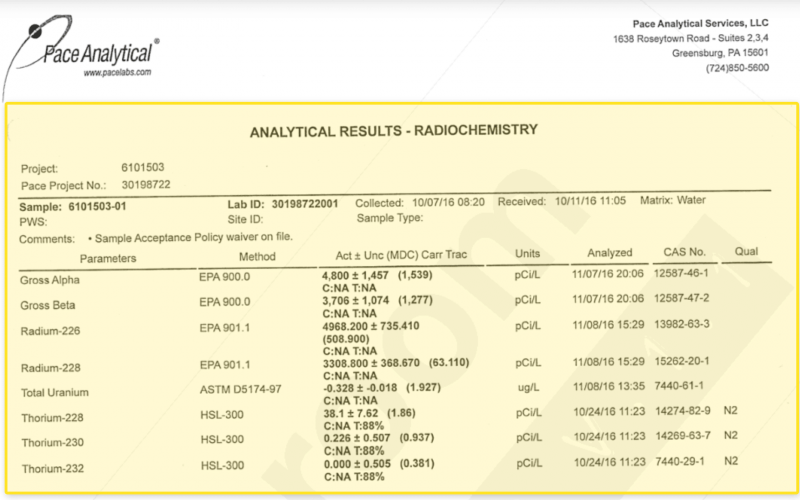The Road Paved In Waste: Fracking waste facility proposed for Allegheny River
Public Hearing Re: Fracking Wastewater Treatment Plant Proposed for Upper Allegheny River – Tuesday, January 16th
This Tuesday evening, January 16th, there will be a presentation and public hearing about the fracking wastewater treatment facility proposed along the Allegheny River in Coudersport, PA. The wastewater will be treated by a company called Epiphany and the Coudersport Area Municipal Authority, or CAMA. The public is invited to attend and give public testimony.
I have a few very specific questions about the facility, but first I want to point out what this facility is versus what it has been called by Epiphany, DEP, and leaders of the community.
The proposed facility is for wastewater treatment, not water treatment. If you look up “water” in the dictionary, it in no way describes what JKLM Energy and other fracking companies will be trucking to and disposing of at this facility.
But in Epiphany’s application to DEP, the “site name” for this project is “centralized water treatment facility.”
If I tell someone in Florida that my town is getting a new “water treatment” facility, they are certainly not getting the whole picture. And neither will anyone else. But perhaps that’s the goal – to create a picture that is incomplete.
Words are important, names are important, and the fact that this facility is not accurately and transparently named is a discouraging place to start.
In Epiphany’s application to DEP, this facility is also called a “produced water treatment plant” in the site description. The average person does not know what “produced water” is or what it contains. “Produced water” is actually fracking waste. It contains naturally-occurring radioactive materials (NORM), heavy metals, and fracking chemicals.
Now that we know exactly what this facility is, let’s get clearer about what this facility actually does versus what local leaders have been told it does.
According to local officials involved in this project, waste will be treated so perfectly by this facility that it will turn back into “pure water” – pure.
This tells me one thing: someone, somewhere, has literally had an epiphany. Someone has figured out how to turn toxic, radioactive waste that is laced with fracking chemicals into “pure water.” This is indeed profound and game-changing – now, we can suck out all the pure water we want out of our rivers, contaminate the crap out of it, turn it back into pure water, and put it right back in our rivers where it came from.
Maybe the name of Epiphany’s “water treatment” facility really is accurate…
Or maybe the notion that what this facility will be producing is only “pure water” is ridiculous and dishonest.
If this facility is really going to produce “pure, clean water,” like Epiphany’s application to DEP claims, then I’m sure they and local leaders won’t mind drinking a glass of it. Bottoms up!
In Epiphany’s application to DEP, the company states that up to 42,000 gallons of waste “distillate” will be sent to Coudersport’s sewage treatment facility (CAMA) every day. In addition, up to 2.5 tons of “dewatered sludge cake” will be removed from the facility and taken to landfills – every day.
It’s in this fine print that the true nature of what this facility does is revealed: it will not simply take in “water” and make it “pure” again. It will take in toxic waste, and it will produce toxic waste – two very important facts that are absent from the discussions I’ve heard at and read in the minutes of Coudersport Borough and CAMA meetings.
I have a few questions about the equipment and processes proposed for this facility, questions that every elected official and board member should already know the answers to:
- Will wastewater be tested for radiologicals a) coming into and b) prior to being discharged, post-treatment, into the river?
- According to Epiphany’s application, the “influent” and “effluent” parameters do NOT include radiologicals. Is the testing of radiologicals NOT required?
- According to several experts and scientists I’ve consulted about this project, the only equipment they would trust when testing for the radioactive materials related to fracking waste is gamma spectrometry. Therefore…Will Epiphany’s or CAMA’s facilities use gamma spectrometry equipment to test for radioactive materials after treatment and before any material is discharged back into the river?
- Epiphany indicated in its application to DEP that the facility will produce air emissions. Will the facility be required to obtain permits for those air emissions?
- According to Epiphany’s application to DEP, the PA Fish & Boat Commission has highlighted potential impacts of this facility on two “endangered” or “threatened” species. How will the health of these species be monitored in the river downstream from this discharge facility?
This facility depends upon the trucking of millions and millions of gallons of fracking waste into our community every year. It was JKLM Energy who came to CAMA with plans for this facility, bemoaning the need to truck their waste elsewhere. So let’s look at what JKLM has done to be so rewarded with cheaper waste disposal. According to DEP’s oil and gas compliance report, JKLM:
- Has amassed 44 violations in Potter County since 2015 which include spilling hundreds of gallons of acid, “failure to properly store, transport, process or dispose of waste,” and contamination of “waters of the Commonwealth.”
- Accumulated 877 violations as its former iteration, East Resources, founded by Terry Pegula in 1983 and operated by staff who now work with JKLM Energy.
- Had six outstanding violations just last month, in December 2017, at its Reese Hollow pad for “Failure to notify the Department of an accident or other activity or incident, a toxic substance or another substance which would endanger downstream users of the waters,” “failure to design and construct well site to prevent spills,” and failure to control waste (again).
- And let us not forget the incompetence that led to the use of unapproved chemicals that contaminated groundwater and polluting drinking water supplies of the residents of this county in 2015.
In Warren, PA, the Allegheny River was contaminated several years ago when fracking wastewater was improperly treated and discharged into the river, and radioactive sediment remains to this day. Waste Treatment Corp, who at least had a transparent name, treated the same waste that Epiphany proposes to treat here in Coudersport. Epiphany will be using different equipment, but the point remains – this is radioactive waste, not “water.”
Only six months ago, in July 2017, Penn State University released a report stating that discharging “treated hydraulic fracturing wastewater” into rivers “may have longer-lasting effects than originally thought.” So let’s be very clear about the processes that will be used so that mistakes are not repeated in our part of the Allegheny River watershed.
I asked the Eulalia Township Supervisors and the Potter County Commissioners if they submitted any questions to DEP after they received letters in July 2017 from Epiphany notifying them of the proposed facility. According to Nancy Grupp and Dawn Wooster, neither government body submitted any questions.
CAMA officials talk about the processes or equipment that will be used at the facility in weak generalizations or have no answers at all.
What this means, is that our community leaders are not leading, they are being led. And the road they’re being led down will be paved in waste.
A public meeting is scheduled for 5:30pm, Tuesday, January 16th, at the Gunzburger Building in downtown Coudersport.






I will be attending this meeting.
We asked Mike Broeker of Epiphany why the Department of State had no record of “Epiphany Allegheny LLC” on Dec. 19th 2017 during a CAMA meeting. On Dec. 20, 2017 (according to the Department of Sate) Epiphany Allegheny LLC registered with the state. and became a bona fide company. If we didn’t ask, I highly doubt Epiphany Allegheny LLC would have ever registered as an actual business entity with the state. The DEP engineer spent months reviewing the application of a company that didn’t exist.
CAMA poured over 20K of sewage customer’s money into their business venture with a company that didn’t exist.
https://uploads.disquscdn.com/images/34df2c03434f6b63897990821b9fc231e59d836c278b8935f9cd0d40cf064f4c.jpg
Size matters! The letter of intent, signed by Epiphany and CAMA indicates this is only a start and they intend to expand the facility: https://uploads.disquscdn.com/images/b9defbd8135945b5d2269cf1f1ecec15fee7a23eaaa3acb2828590eb0af5fe95.jpg
See the “Letter of Intent” here: https://docs.google.com/document/d/1TLXCWG3NjURXXuffvR19OO_1O5t6MyhAI1zgLmww8u4/edit?usp=sharing
Ra-226 is soluble in water and is not removed by wastewater treatment methods. It comes from the shale formation, not the fluid injected into it. Frack fluid reused several times will approach in concentration the Ra-226 in the formation, which is leached into the water-based fluid each time it’s sent down into the formation. The high concentration in the sample report above (4968 pCi/L ± 735.4; background is 0.85 pCi/L), should be multiplied by the anticipated volume of wastewater to be discharged to obtain the mass of Ra-226 to be discharged. Since Ra-226 is a bioaccumulative persistent compound, it does not degrade (half-life = 1,600 yrs.) and concentrations grow exponentially in biota as one moves up the food chain, to fish and the humans who eat them. At that point, the Ra-226 concentration is far higher than the lab report indicates for the wastewater alone. Ask how the project sponsor will avoid this outcome; don’t settle for mitigation (payment for a firehall, for example).
Is that an MF’ing redhead in the banner pic?